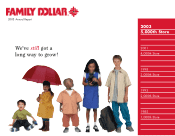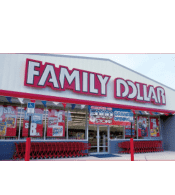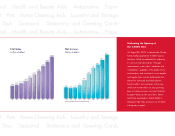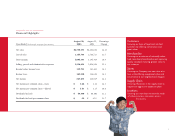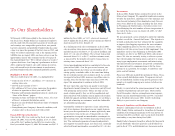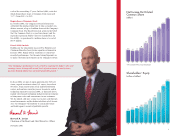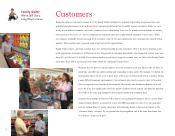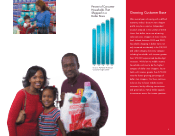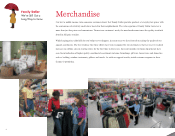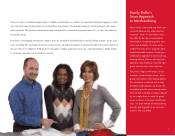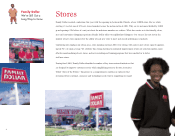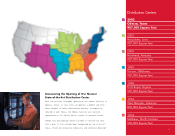Family Dollar 2003 Annual Report Download - page 6
Download and view the complete annual report
Please find page 6 of the 2003 Family Dollar annual report below. You can navigate through the pages in the report by either clicking on the pages listed below, or by using the keyword search tool below to find specific information within the annual report.
2
With nearly 3,000 stores added to the chain in the last
ten fiscal years, Family Dollar has experienced explosive
growth. And with 30 consecutive quarters of record sales
and earnings on a comparable quarter basis, our growth
has been consistent and profitable. Family Dollar has come
a long way since the opening of the first store in 1959, and
while we celebrate milestones such as the opening of the
5,000th store in August 2003, our focus always is on the
opportunities ahead. The statement on the cover page of
this Annual Report that “We’ve still got a long way to grow!”
captures this focus. Our Company’s performance in fiscal
2003, coupling the highest sales and earnings in our his-
tory with record levels of reinvestment in our business,
positions Family Dollar for continued profitable growth.
Highlights of Fiscal 2003
The year ended August 30, 2003, was highlighted by:
• Gains in sales of 14.1%, including a 3.8% increase in
existing store sales
• Growth in net income of 14.1%
• Net addition of 411 new stores, increasing the number
of stores in operation at fiscal year-end to 5,027
• Planning and beginning implementation of a multi-year
“Store of the Future” project
• Opening on-time, on-budget in Odessa, Texas, of a state-
of-the-art, automated distribution center
• Increase in cash dividends declared per share of Common
Stock of 13.7%
• Strengthening our Company’s financial condition, with
a balance sheet at fiscal year-end with no debt
Fiscal 2003 Operating Results
Sales for the fifty-two weeks in the fiscal year ended
August 30, 2003, were $4,750.2 million, or 14.1% above
sales of $4,162.7 million for the fifty-two weeks in the
fiscal year ended August 31, 2002. Net income was $247.5
million for fiscal 2003, or 14.1% above net income of
$216.9 million for fiscal 2002, and net income per diluted
share increased to $1.43 from $1.25.
In a challenging retail sales environment, in fiscal 2003
sales in existing stores increased approximately 3.8%. This
included increases of about 4.3% in sales of hardlines and
about 2.1% in sales of softlines. The average transaction
increased about 1.6% to $8.87, and the customer count,
as measured by the number of register transactions in
existing stores, increased about 1.9%.
Several merchandising initiatives contributed to the sales
gains in fiscal 2003. Over the past several seasons, our
apparel departments have done an outstanding job of
raising quality standards while at the same time hitting
the low-end price points our customers need. As a result,
we reported in fiscal 2003 increases in softline sales in
existing stores for the first time since fiscal 1999. We
expect this momentum to continue in fiscal 2004.
We have taken this same focus on quality to our home
departments (mainly domestics, housewares and giftware)
with promising initial results. Today, not only are the
goods a higher quality, they are better coordinated and
more consistent with fashions seen in higher end retailers.
In both the apparel and home departments, we are doing a
better job of meeting our customers’ needs for fashionable
yet affordable merchandise.
Consumables continue to represent a large and growing
part of our business. Investments in our supply chain in
recent years have positioned us to more aggressively man-
age inventory turns in this area. This provides us with
opportunities to expand our merchandise assortments to
drive existing store sales without increasing overall inven-
tory. The continued expansion of name brand products
also supports our quality image. Last fiscal year, nationally
advertised brand merchandise accounted for 35% of sales.
Investments
In fiscal 2003, Family Dollar continued to invest in the
future of our Company. We committed significant resources
towards key initiatives, including new store openings and
store focused technology. Four hundred seventy-five new
stores were added to the chain, including the first stores
in Wyoming and North Dakota. Sixty-four stores were
closed bringing the total number of stores in operation at
the end of the fiscal year on August 30, 2003, to 5,027
stores in 43 states.
We also announced a series of initiatives under the umbrella
of what we call the “Store of the Future.” The objective is
to build an infrastructure that will provide the capability
to improve the shopping experience for our customers
while simplifying processes for our Associates. These
initiatives will take several years to fully implement. One
immediate result is that beginning in November 2003
customers are able to use PIN-based debit cards in most
stores. We also are currently testing a software system
that will streamline the hiring process and give us consis-
tency in pre-employment assessments and interviewing.
The infrastructure investments also provide a foundation
for more interactive communications with the stores,
putting us in a position, for example, to introduce com-
puter assisted training.
Fiscal year 2003 also marked the opening in Odessa, Texas,
of our seventh distribution center. We open our state-of-
the-art distribution facilities using proven processes that
permit us to rapidly ramp-up new centers to full-service
standards.
Finally, we invested in the senior management team with
a number of promotions and new hires. Most notably,
David Alexander, who has assumed increasing responsi-
bilities since he joined Family Dollar in 1995, succeeded
me as President in January 2003. David’s leadership
ability is a great asset to our Company.
Financial Condition and Dividend Growth
Despite a challenging retail sales environment in fiscal
2003, Family Dollar continued to strengthen its financial
condition. The Company maintains its 44-year history of
no long-term debt, and there also was no short-term debt
outstanding at any time during fiscal 2003.
Family Dollar’s financial strength is reflected by the growth
of cash dividends. The first quarterly cash dividend was
paid in fiscal 1976, and dividends have been increased in
To Our Shareholders

